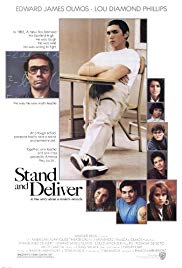MALE ROLE MODEL
1. Do you think that Mr. Escalante is a role model for a teacher?
2. The film shows some of Mr. Escalante’s mistakes. Can you describe three of them?
SELF-ESTEEM
3. Would you be willing to give up your mornings, afternoons, and weekends, and a good part of your summer to prove to yourself that you could learn calculus and pass the AP Calculus test?
4. Describe the corrosive effects of the loss of self-esteem to the students in this film before they met Mr. Escalante.
EDUCATION
5. One of Mr. Escalante’s special qualities was that he had high expectations for his students. What is the importance of a teacher’s expectations for a class?
6. Did Mr. Escalante do the right thing in going to the restaurant owned by the family of one of his female students to persuade the girl’s father to allow her to attend the extra calculus classes? What is the appropriate role for a teacher when communicating with a student’s family?
7. Describe some of the techniques that Mr. Escalante used to keep his students interested in the class.
8. Remember the lady who was head of the math department at Garfield High School? This teacher had low expectations for her students and thought that Mr. Escalante’s students had cheated. What caused her to have these attitudes?
9. What does this film tell you about the special contributions that inspiring teachers can make to their students and their community?
TRUSTWORTHINESS
(Be honest; Don’t deceive, cheat or steal; Be reliable — do what you say you’ll do; Have the courage to do the right thing; Build a good reputation; Be loyal — stand by your family, friends and country)
1. The ETS was faced with strong evidence that the students had cheated. This came from their incorrect responses to Free Response Question #6, in which most of the class applied the same incorrect formula to the problem and made an identical mistake in simplifying a fraction, a type of calculation that they had been doing correctly since the 6th or 7th grade. Assume that the students cheated on Free Response Question #6. Discuss the role of the law of unintended consequences in the outcome of this situation.
2. Assume that the students cheated on Free Response Question #6. Describe three reasons why cheating at school is not a good idea and how this relates to the situation of the students in Mr. Escalante’s class.
RESPONSIBILITY
(Do what you are supposed to do; Persevere: keep on trying!; Always do your best; Use self-control; Be self-disciplined; Think before you act — consider the consequences; Be accountable for your choices)
3. Many teachers and school administrators, as well as children and parents have seen this film. Why aren’t all children taking the AP Calculus test or engaging in some other specialized effort to excel? What about you? Are you making some special effort in your life to excel?
4. Mr. Escalante got angry at Angel and unfairly punished him. The only reason that this did not have disastrous consequences was that Angel was committed and resourceful. How does this incident show the need for self-control by both Angel and Mr. Escalante?


